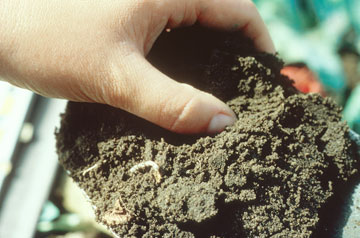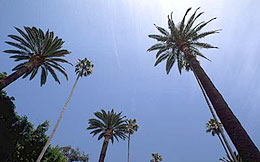Salinity Management Guide

Sandy soil
About the differences soil and climate make
A sandy soil, with its relatively large, loosely packed particles, easily absorbs and drains water. In contrast, a clay soil, which has smaller, more closely packed particles, less readily absorbs and drains water. Loamy soil falls somewhere in between: a mixture of sand, organic material, and clay, it absorbs and drains water less quickly than sandy soil, but not as slowly as clay soil. Salt in a sandy soil is more easily leached past the area near plants' roots. For a clay soil, short and repeated irrigations will help to keep the area around roots well watered. Problems with a clay soil's slow drainage often can be mitigated by applying gypsum or injecting buffered acid, either of which loosens the soil and allows water to drain more readily through it.

Cool, humid weather
Most plants tolerate salt better when the weather is cool and humid than when the weather is hot and dry. This is because soil retains moisture better in cool and humid weather, which helps to decrease the concentration of salt in the soil nearest the roots. During spells of hot, dry weather, the reverse occurs: the soil rapidly becomes drier, which increases the concentration of salt in the soil nearest the roots, sometimes to a level that injures plants. Irrigating more often and using more water than usual with each irrigation is helpful.

Warm, dry weather
Also, hot temperatures intensify the injury that sodium and chloride inflict on the leaves of sprinkler-irrigated plants. Use enough sprinkler-irrigated water to wash excess salt from leaves. If the water is known to contain excessive salt, avoid frequent and light sprinklings. They can contribute to the accumulation of salt on leaves.
| « Previous page | Next page » |